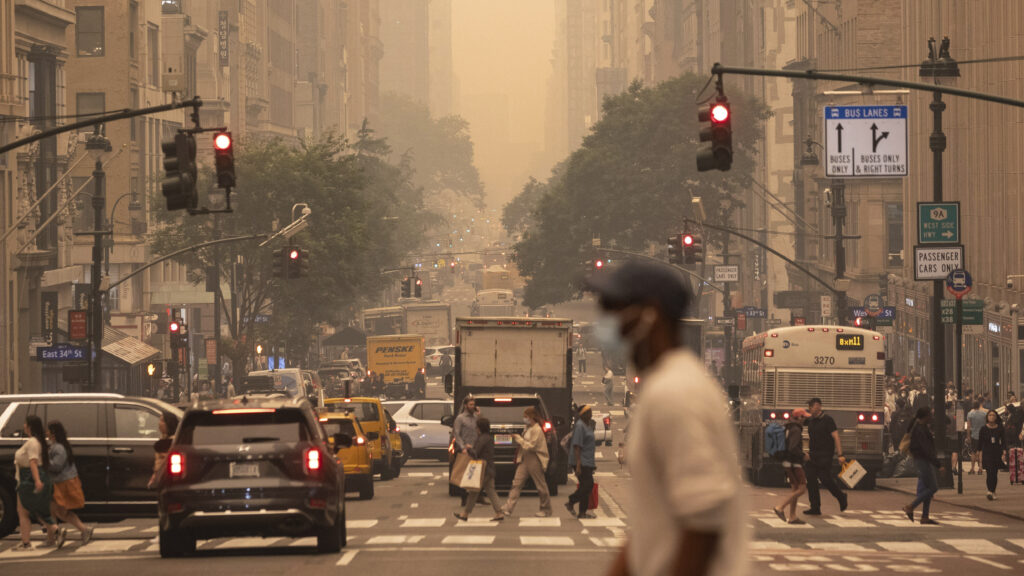Wildfires blazing in and around Quebec are creating hazardous health conditions throughout North America. Over 100 million people were under alerts for unhealthy air quality as of Wednesday, and people in the Northeast and Midwest — areas that typically don’t deal with the effects of wildfires — are confronting orange-tinged, hazy skies and newly urgent questions about the harmful effects of air pollution.
Fine particulate matter, the tiny bits that make up those clouds of haze, is a major health concern that’s already a part of daily life for people in cities like Beijing, New Delhi, and Santiago, Chile. Canadian authorities and state officials in the U.S. have advised people in affected areas to avoid unnecessary outdoor activities, and to shut windows and doors.
For those newer to dealing with air quality concerns, here’s what you need to know.
How does air pollution from wildfires impact our health?
Fine particles can be liquid or solid residue from dusty manufacturing sites, car exhaust, or sooty environments, as well as byproducts from fires, among other things. Aside from causing eye irritation, smoke from fires can also carry harmful particulate matter far and wide.
Particles with a diameter of less than 10 microns are dangerous — they can be inhaled deep into the lungs or even get into the bloodstream due to their small size. From there, they trigger inflammation of the airways and other organs, including the heart, kidney and liver. Inflammation sets off the body’s defense system, which can injure cells, alter gene expression, and lead to scarring and disease.
Even brief exposure to fine particulates can be harmful. They’ve been associated with higher rates of hospital admission for cardiovascular disease, diabetes and kidney failure.
Particles with a diameter of 2.5 microns or less, or PM2.5, are considered even more dangerous when breathed in at high enough levels. PM2.5 have been linked to increased risk of heart attack, stroke, and lung cancer. This kind of air pollution is especially risky for pregnant people, babies and children, older adults, and people with lung or heart disease.
Poor air quality can spur or worsen respiratory conditions, such as emphysema, chronic obstructive pulmonary disease — a leading cause of death in the U.S. — and asthma. Children with asthma might have exacerbations, or flare-ups, during periods of hazardous air quality.
Recent studies have also found evidence that exposure to PM2.5 could make the body more susceptible to infections and neurodegenerative diseases.
Wildfire smoke has been found to be among the most toxic to people when compared to fine particles from other sources, such as dust or soil carried by the wind. That’s in part because of the chemical composition of the particles, which is altered by combustion, and can trigger a more severe inflammatory response.
Why air pollution is a health equity issue
People who live in low-income communities are disproportionately affected by low-quality air, typically because of their proximity to major polluters, like factories, ports, and highways. But smoke from wildfires can also pose particular risks to marginalized communities.
For one thing, poor areas and communities of color also tend to have elevated rates of chronic conditions that make inhaling fine particles that much more hazardous. Outdoor workers, including agricultural laborers, landscapers, and construction workers, are also more likely to have frequent exposure to bad air.
As the earth’s climate changes, heat waves like those seen last summer are projected to happen more often — and a heat wave in combination with a drought, like historic ones in the Western U.S., means higher risk of fires. The people most likely to feel the heaviest impacts of fires and smoke are those without access to well-ventilated housing and workplaces, or to affordable health care that allows them to catch problems early.
Under future climate change, more than 82 million people will experience a 57% increase in the frequency of wildfire smoke waves, with the western U.S. and Great Plains likely to have the highest exposure, according to a 2016 study co-authored by Francesca Dominici, co-director of the Harvard Data Science Initiative.
“We are now starting to see” these predictions come to fruition, Dominici said. “I mean, it was very unusual to have this level of wildfire smoke in the eastern parts of the United States, and now it’s here.”
Beyond the near-term health impacts, the devastation of wildfires can also have long-lasting effects on communities’ mental health. Fires can destabilize whole regions as homes and businesses are lost or damaged, and recovery can take years or decades.
“What’s concerning is the fact that, as always, some of the most vulnerable people that have to work outside all day and they already have underlying conditions, or people that cannot protect themselves, these are the ones that have the higher risk,” said Dominici, who is also a professor of biostatistics, population and data science at the Harvard T.H. Chan School of Public Health.
What to do in the face of poor air quality
The Environmental Protection Agency recently tightened its air quality standards for particulate matter. But many researchers say the new levels of acceptable pollution are still too high, and not sufficiently protective of people’s health.
These thresholds, which help local and federal officials craft policies for high-pollution areas, also can’t do much when environmental crises like the Canadian wildfires occur. EPA rules permit up to 35 micrograms of fine particles per cubic meter of air in a 24-hour span. This week in New York City, the rate was close to 100 micrograms.
Wearing an N95 mask outdoors can help, but experts advise people to avoid the outdoors, including exercising outdoors. (People tend to inhale 10 to 20 times more air while exercising.) Running an air purifier indoors can also help filter out particles that made their way into homes and offices. The EPA also recommends keeping vacuums in the closet to avoid blowing particulate matter into the air, and keeping wood fireplaces, gas stoves, and candles off.


